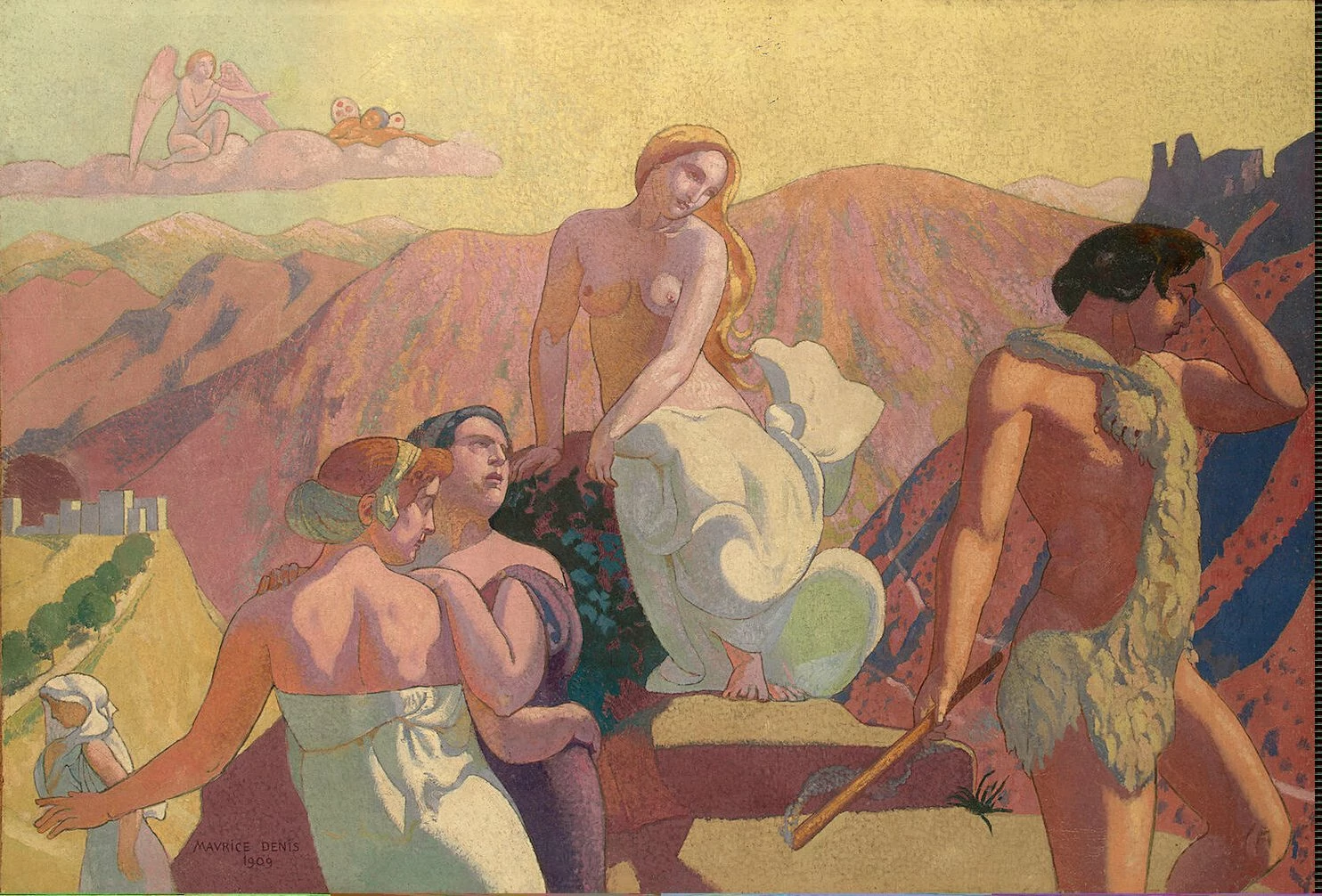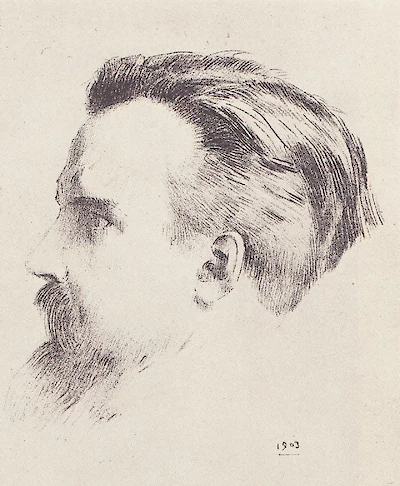

Maurice Denis
Art as prophesy
1870 – 1943A letter to Vuillard
February 15, 1898.
I am delighted that you thought of writing to me. As a matter of fact, I have been thinking of you a lot the last few days, and not at all because of the Dreyfus affair. Rome is having its effect on us, we are happy here; I feel very good, my nervous system rather feels better than in Florence. I am absolutely conquered by the beauty of the gardens, the sumptuousness of the fountains, the poetry of ruins. There are a number of old basilica, I discover them everyday, and it is, with all due respect to the memory of the martyrs, the reason why those monuments of the early Christian art are so valuable. I redo, I make corrections, I substantiate my article in L’Art et la Vie. I make copious notes, since so many ideas come to me about all those new things… I am beginning to understand Raphael now, and this is, I think, a noteworthy phase in a painter’s life. Most certainly, this man was a wonder. In twenty years, he explored all the possibilities of his art, tried everything, succeded at it, he had an incredible flair for variety. But, and this is where, these days, you and I disagree, we must consider all the aspects of his artwork, of almost all of it. I think that we are wrong to expect artwork to give us immediate gratification, to find it outwardly pleasant, and to think too much, while we are working, to the qualities of aspect found magnified in a large quantity of mediocre, short-lived, and vain artwork, that is, in fact, entirely without any profoundly beautiful thing. There is in that a mistake, a fad, an overrated reaction against academic degeneration, and we must become cognizant of it. Nothing is more ugly than the Last Judgment, and yet, it is a marvel of a painting. Same thing for the Raphaels that are at the Vatican, which could pass, at first glance, for any clear, harmonious, expressive Primitive. When you love them, you must prefer them to anything else. You will note that one could say the same thing about Poussin and Ingres, who are but the continuation of individuals like Raphael. What makes a piece of artwork significant, is the fullness of the artist’s efforts, the powerfulness of his or her will. This is why we understand that in Rome, all the painters of this grande époque and their admirable pupils, like Poussin or Ingres, had only their finished artwork in mind. I do not know of a place that is more at the opposite extreme of Impressionism. Here, you barely think about noting the little day to day impressions you have that are so delicious. Here, you feel the strength to begin a piece of artwork that will take you two years to complete, like the Vow of Louis XIII, I think. I will probably return home strengthened by the ideas that I have expressed to you on prior occasions on that subject, when I was making my first portrait at the last salon.
February 22,1898.
My dear Vuillard, It is in front of Raphaels at the Vatican that I have carefully gone over your letter. It is a most precious and genuine psychological confession. That said, here is how I dissected your letter. I do not want to spoil it, for I dearly appreciate it. I used a pencil to divide it in paragraphs, so that I could understand it better, and, if you will let me, here is a brief summary of it. I use the word theory to mean: “a general idea concerning painting.” So:
Here is in a very plain form what your letter contains. It seems that you were trying to justify yourself. You tell me that I am trying to take you to task, this would be the last thing I would do. You have produced enough important things and you know and everybody knows too how well I think of you. I am still glad though that you felt touched by the observations that Rome suggested to me, and I would be grateful for submitting my question to you with the greatest clarity possible. This confidence in your instinct, which does not mislead you for that matter, and which results from an overabundance of natural talents, we would call sensualism. Thadeus Natanson’s articles or opinions, for example, are its systematic demonstration and provide the theory for it. In aesthetics, this concept of beauty, you understand, relates to that type of theory. And in art, it is the tendency to note the impressions. In ethics, in philosophy…but this would take too long. On the other side, Raphael, who is exactly at the opposite end, epitomizes the theory of the ideal. Endeavor towards reason, and science towards style, that is, as whispers Gide to me, is a system of subordinations. I think also of the expression “style châtié” [purist style], a bit of a pun that puts the idea of perpetual punishment into your head, and I come to realize that classical art is made up of sacrifice, at the expense of, if you will, natural proclivities, work based on instincts, and favoring reasoning and ideal.
In the first case, ours, there is an aggrandizement of the individual, of his originality, his temperamental, irregular, spasmodic work, in accordance with life itself. In Raphael’s case, the man disappears completely into the art, and that is why those who do not possess robust talent, do not resist that discipline (school of Raphael, of Ingres, etc.). The effort, then, instead of being some sort of quotidian review, becomes a long-term undertaking. Here is where the problem gets a whole lot more complicated, and touches upon what I noticed was so novel in Rome, what motivated the explosion of my first letter: the habit of instant gratification, the instinctual confidence in and the carelessness of theories, have created an increasingly insatiable thirst for pleasure, and brought on an exaggerated refinement of sensibilities. From which stems our expectations of what aspect art should have. This tendency is so opposite to that which produced the great works of classical art, that I have come to feel concerned about this, generally speaking, you understand? If you think about it, you will see how serious it is. Other cause for worry: Since the Symbolist movement, the work of an artist has become more subjective than ever. Any emotion can become the subject of an art piece. Consequently, the twenty-four hours of every day are not enough to take notes on all the emotions felt: you can manage to preserve quite a bit, quick blocks of simplifications, on a piece of canvas or cardboard. You spend your life keeping a sort of diary, in the form of quickly drawn paintings, a sort of stenography of daily sensations. I am certain that Raphael did not proceed like that. The Impressionists themselves still function working from models, from nature, which requires proceeding slowly, and analyzing; while we…
Notes taken on Raphael at the Vatican:
February 16, 1904.
The Transfiguration is of course a masterpiece, from the ancients’ point of view; it is the tour de force in painting. Not one detail left to chance, nothing neglected. (The book on the left, with its worn binding, its bookmarks, its clasps, the verdure in the foreground, hands, feet.). The style of the contours or of the “chiaroscuro.” Drawing of the heads, drapery, feet, hands, always diverse yet remaining classical. (Remember especially how the drapery falls on the kneeling woman and the draping on the shoulder, on the left.). So, while imitating from nature and inventing means of expression or décor, nothing is useless or insufficiant. The artist never goes too far. He demonstrates consistency, unity, the most complete harmony, and he achieves that by some sacrifices, of which some elements of tones (values), that we disapprove of in this painting: here is where Poussin’s good old fashion paintings, and also the frescoes found at the Signature, are far superior.
So, while imitating from nature and inventing means of expression or décor, nothing is useless or insufficiant. The artist never goes too far.
The shades are boring, except maybe to the top, where they fit well. Sacrifices in the drapings, outlines and figures. It is incredible that a man, the same who painted the Borghese’s Entombment, could get to finish, at such a young age, a simplification, showing such fluidity. Noticed the artful stratagem of composition that made possible all figures to bend, kneel, etc., so that only one could stand, that of Christ. The Martyrdom of SaintEustachius is but a debutant’s next to it. The Eucharist is prepared like a modern canvas: the image is packed, the lines ethereal, there is no willpower. — In the frescoes found at the Signature, where colors are so decorative, so mural, the sense of values so methodical, we perceive perfection, we feel sublimated, engulfed.
Wednesday, March 2, 1904.
Last visit at the Vatican. Using the chiaroscuro, there are more sacrifices in Raphael’s than in Fra Angelico’s frescoes where all the figures are equally important, where all the traits are expressed the same. Raphael took advantage of everything, he is at the point of contact where style meets with picturesque, where nature and architecture merge. Woman’s hip in the Transfiguration. What beauties! And I shed a few tears visiting Saint Peter one last time.